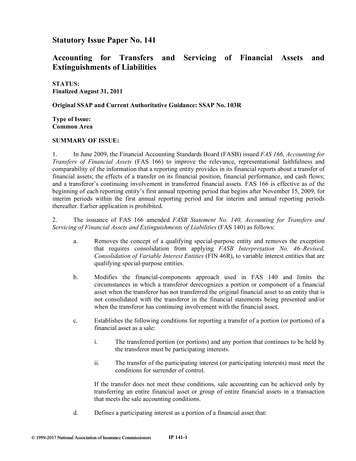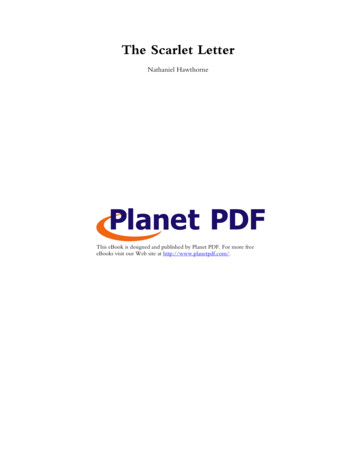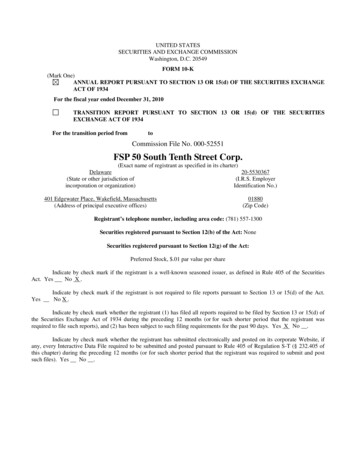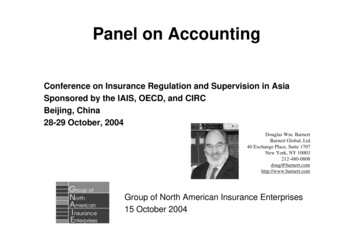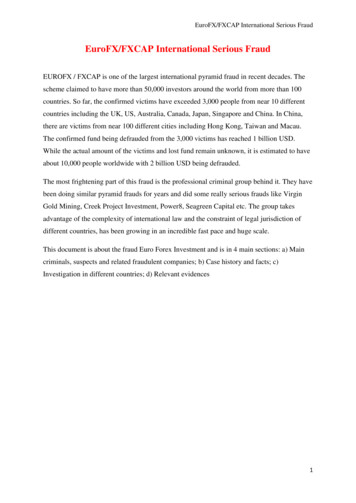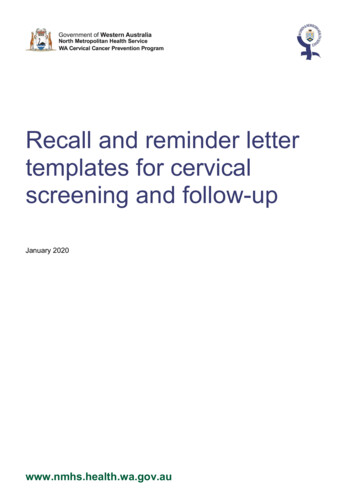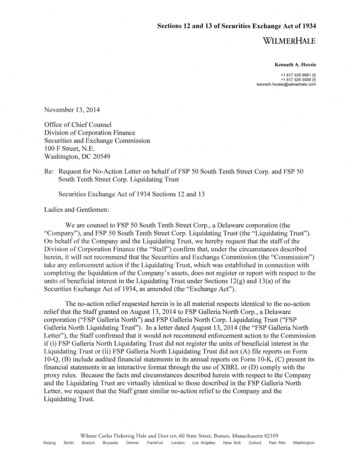
Transcription
Sections 12 and 13 of Securities Exchange Act of 1934WILMERHALEKenneth A. Hoxsie 1 617 526 6681 (t) 1 617 526 5000 (f)kenneth.hoxsie@wilmerhale.comNovember 13,2014Office of Chief CounselDivision of Corporation FinanceSecurities and Exchange Commission100 F Street, N.E.Washington, DC 20549Re: Request for No-Action Letter on behalf ofFSP 50 South Tenth Street Corp. and FSP 50South Tenth Street Corp. Liquidating TrustSecurities Exchange Act of 1934 Sections 12 and 13Ladies and Gentlemen:We are counsel to FSP 50 South Tenth Street Corp., a Delaware corporation (the"Company"), and FSP 50 South Tenth Street Corp. Liquidating Trust (the "Liquidating Trust").On behalf of the Company and the Liquidating Trust, we hereby request that the staff of theDivision of Corporation Finance (the "Staff') confirm that, under the circumstances describedherein, it will not recommend that the Securities and Exchange Commission (the "Commission")take any enforcement action if the Liquidating Trust, which was established in connection withcompleting the liquidation of the Company's assets, does not register or report with respect to theunits ofbeneficial interest in the Liquidating Trust under Sections 12(g) and 13(a) of theSecurities Exchange Act of 1934, as amended (the "Exchange Act").The no-action relief requested herein is in all material respects identical to the no-actionrelief that the Staff granted on August 13, 2014 to FSP Galleria North Corp., a Delawarecorporation ("FSP Galleria North") and FSP Galleria North Corp. Liquidating Trust ("FSPGalleria North Liquidating Trust"). In a letter dated August 13, 2014 (the "FSP Galleria NorthLetter"), the Staff confirmed that it would not recommend enforcement action to the Commissionif (i) FSP Galleria North Liquidating Trust did not register the units of beneficial interest in theLiquidating Trust or (ii) FSP Galleria North Liquidating Trust did not (A) file reports on Form10-Q, (B) include audited financial statements in its annual reports on Form 10-K, (C) present itsfinancial statements in an interactive format through the use of XBRL or (D) comply with theproxy rules. Because the facts and circumstances described herein with respect to the Companyand the Liquidating Trust are virtually identical to those described in the FSP Galleria NorthLetter, we request that the Staff grant similar no-action relief to the Company and theLiquidating Trust.Wilmer Cutler Pickering Hale and 60 State Street, Boston, Massachusetts 02109LondonLos AngelesNew YorkOxfordPalo AltoWashington
WILMERHALEOffice of Chief CounselNovember 13,2014Page 2BACKGROUND OF THE COMPANY AND THE LIQUIDATING TRUSTThe Company was incorporated on September 12, 2006. It was formed to purchase, ownand operate a twelve-story multi-tenant office and retail building, containing approximately498,768 rentable square feet of space in Minneapolis, Minnesota (the "Property"). TheCompany purchased the Property from an unaffiliated third party for 127,000,000 on November8, 2006.Between November 2006 and January 2007, the Company sold an aggregate of700shares of preferred stock in a private placement offering to 627 "accredited investors" within themeaning of Regulation D under the Securities Act of 1933, as amended (the "Securities Act") foran aggregate consideration of approximately 70,000,000 (the "Private Placement"). On June 5,2007, the Company registered its preferred stock under Section 12(g) of the Exchange Actbecause it had in excess of 500 holders of record and at least 10 million in assets as ofDecember 31, 2006. The Company has not registered, and is not required to register, any otherclasses of securities under Section 12 of the Exchange Act, nor are any classes of the Company'ssecurities subject to reporting under Section 15(d) of the Exchange Act. Prior to the Company'sdissolution, American Stock Transfer & Trust Company served as the transfer agent for thepreferred stock.Immediately prior to the Company's dissolution on September 3, 2014, there were 700shares of preferred stock held by 638 holders of record and one share of common stockoutstanding. Franklin Street Properties Corp. ("Franklin Street") held the sole share of theCompany's common stock.The Company's preferred and common stock have never been listed or traded on anyexchange or trading system or any "pink sheets" or bulletin board listing service, and there hasbeen no public market for, or active trading of, the stock. There have never been any marketmakers for the Company's stock. Prior to the Company's dissolution, the Company's preferredstock was traded through infrequent privately negotiated sales between Company stockholdersand prospective buyers. During 2014, and prior to the Dissolution Date (as defined below), atotal of 17 transfers of the Company's preferred stock were effected, as follows:1. 1 transfer of 0.25 share of preferred stock was effected in a privately negotiatedsale between an existing Company stockholder and a prospective buyer.2. 16 transfers of an aggregate of 9.50 shares of preferred stock were effected inordinary course transfers (other than sales between existing Companystockholders and prospective buyers and sellers), including transfers by operationof law (i.e., deaths and divorces) and estate planning.
WILMERHALEOffice of Chief CounselNovember 13, 2014Page 3Prior to its dissolution, the Company operated in a manner intended to qualify as a realestate investment trust, or REIT, for United States federal income tax purposes.On May 8, 2014, the board of directors of the Company approved (i) the sale of theProperty, comprising a sale of substantially all assets under the General Corporation Law of theState of Delaware (the "DGCL"), to an unaffiliated third-party buyer for a gross sales price in theaggregate of no less than 164,500,000 (the "Sale") and (ii) the subsequent dissolution oftheCompany and the adoption of a plan of complete dissolution and liquidation (the "Plan ofDissolution"). On August 7, 2014, the Company mailed a Proxy Statement (the "ProxyStatement") to its stockholders seeking advance stockholder approval of the Sale and thesubsequent dissolution ofthe Company and adoption ofthe Plan of Dissolution, as required bythe DGCL. On August 18,2014, the Company received the required vote ofthe stockholdersunder the DGCL approving the Sale and the subsequent dissolution of the Company andadoption of the Plan of Dissolution.On June 25, 2014, the Company entered into an agreement with Union Investment RealEstate GmbH (the "Buyer"), an unaffiliated third-party, for the sale of the Property for a grosssales price of 164,500,000 (the "Purchase and Sale Agreement").On August 22, 2014, in anticipation ofthe sale ofthe Property and the subsequentdissolution of the Company, and pursuant to the Plan of Dissolution, the board of directors of theCompany determined that it would be in the best interests of the Company and its stockholders tocomplete the liquidation of the Company following the sale of the Property by assigning andtransferring to the Liquidating Trust all of the Company's assets, including certain cash and otherreserves set aside for the costs and expenses of the Company in liquidation, as well as any otherexisting or contingent liabilities or obligations of the Company. In fmiherance thereof, theLiquidating Trust was formed on such date pursuant to a liquidating trust agreement (the"Liquidating Trust Agreement") and in accordance therewith FSP Property Management LLCwas appointed trustee of the Liquidating Trust (the "Trustee").On August 25, 2014, in anticipation of the sale of the Property and the subsequentdissolution of the Company, and in order to preserve its qualification as a REIT for United Statesfederal income tax purposes, Franklin Street assigned its sole share of common stock of theCompany to a wholly-owned subsidiary of Franklin Street.On September 2, 2014, the Company consummated the sale ofthe Property to the Buyerfor a 164,500,000 gross sale price.On September 3, 2014 (the "Dissolution Date"), the Company filed its Certificate ofDissolution with the Secretary of State of the State of Delaware, which became effective on thatdate, and transferred all of its assets, claims, obligations and liabilities to the Liquidating Trust.The assets and liabilities transferred by the Company to the Liquidating Trust consisted of
WILMERHALEOffice of Chief CounselNovember 13, 2014Page 4approximately 65,234,949 of cash and cash equivalents, the rights to receive up to 1,645,000in escrow proceeds in accordance with the terms of the Purchase and Sale Agreement and relateddocuments, 647,596 of receivables, and liabilities ofthe Company of 799,143, primarilyconsisting of accounts payable and accrued expenses, taxes and professional fees. On theDissolution Date, in accordance with the Plan of Dissolution and the Liquidating TrustAgreement, the Company's stock records were closed, all ofthe outstanding shares of theCompany's preferred and common stock were cancelled, and each stockholder of the Companyautomatically became the holder of beneficial interests in the Liquidating Trust equal to theirrespective interests in the proceeds of the liquidation of the Company prior to the dissolution.The stockholders were not required to take any action to receive the beneficial interests in theLiquidating Trust. The beneficial interests in the Liquidating Trust are not transferable, exceptby will, intestate succession or by operation of law, nor does a beneficiary of the LiquidatingTrust have authority or power to sell or in any other manner dispose of any such beneficialinterests. Any beneficial interests in the Liquidating Trust transferred by will, intestatesuccession or operation of law will thereafter be subject to such transfer restrictions. Units ofbeneficial interest in the Liquidating Trust are not listed on any exchange or quoted on anyquotation system, nor are they or will they be represented by certificates. As of the DissolutionDate, there were 638 holders of beneficial interests in the Liquidating Trust.Although the Company's dissolution became effective upon the filing of the Certificateof Dissolution with the Secretary of State of the State of Delaware, Section 278 of the DGCLprovides that the Company's existence continues for at least three years after dissolution forlimited purposes. Specifically, the Company will continue to exist for the purpose of prosecutingand defending suits, whether civil, criminal or administrative, by or against it, and enabling theCompany gradually to settle and close its business, to dispose of and convey its property, todischarge its liabilities and to distribute to its stockholders any remaining assets, but not for thepurpose of continuing the business for which the Company was organized.On the Dissolution Date, FSP 50 South Tenth Street LLC, a wholly owned subsidiary ofthe Company, filed a certificate of cancellation with the Secretary of State of the State ofDelaware, which became effective upon filing.On the Dissolution Date, following the dissolution of the Company, the Trusteeauthorized, pursuant to the Liquidating Trust Agreement, an initial liquidating distribution of atotal of 64,400,000 to the beneficiaries of the Liquidating Trust, which amount was to beapportioned pro rata according to the beneficiaries' respective interest in the Liquidating Trust asofthe Dissolution Date (the "Initial Liquidating Distribution"). The Initial LiquidatingDistribution was effected on September 19, 2014. After giving effect to the Initial LiquidatingDistribution, as of September 19, 2014, the Liquidating Trust retained approximately 2,783,149in assets, comprised of 879,736 in cash and cash equivalents, the rights to receive up to 1,645,000 in escrow proceeds in accordance with the terms ofthe Purchase and Sale Agreementand related documents, and 258,413 in receivables, in order to wind up the Company's affairs,
WILMERHALEOffice of Chief CounselNovember 13, 2014Page 5resolve any claims and discharge any liabilities of the Company during the Company's continuedexistence after dissolution under the DGCL as described above. As of September 19; 2014, theknown liabilities ofthe Company were estimated to be approximately 459,571, primarilyconsisting of accounts payable and accrued expenses, taxes and professional fees.On September 19, 2014, the Liquidating Trust effected the conveyance ofthe InitialLiquidating Distribution to the beneficiaries of the Liquidating Trust, comprising 92,000 pershare of preferred stock outstanding as ofthe Dissolution Date.On October 20, 2014, the Company filed a Form 15 pursuant to Rule 12g-4(a)(1) toterminate the registration of the preferred stock under the Exchange Act and to cease filingperiodic reports with respect thereto. The Company determined that it was eligible to rely onthis rule because the Company no longer had any record holders of its preferred stock. Prior tothe date ofthe filing of the Form 15, the Company was current and timely in its reportingobligations under the Exchange Act. Since the date of the filing of the Form 15, the LiquidatingTrust has been current and timely in its reporting obligations under the Exchange Act.Between the Dissolution Date and September 19, 2014, other than the Initial LiquidatingDistribution, the Liquidating Trust collected approximately 389,183 ofreceivables, paidapproximately 339,572 of accounts payable and accrued liabilities, and incurred expenses ofapproximately 4,824.Terms of the Liquidating TrustThe sole purpose ofthe Liquidating Trust is to collect all outstanding assets of theCompany and to liquidate the Liquidating Trust's corpus and discharge the liabilities transferredto it with no objective to continue or engage in the conduct of any trade or business. Under theterms of the Liquidating Trust Agreement, the Trustee is authorized and empowered to take onlysuch action as is necessary or advisable to preserve the Trust corpus pending its distribution tothe owners of the beneficial interests of the Liquidating Trust, and has no power or authority toenter into or engage in the conduct of any trade or business in respect of the Liquidating Trustcorpus. For example, the Trustee is authorized and empowered to settle, prosecute and defendall suits and proceedings including, without limitation, all claims and causes of actions whichcould be brought by or on behalf of the Company, and prosecute or defend all actions against orappeals on behalf of the Company. The Trustee has not brought any claims or causes of actionson behalf of the Company, nor has it prosecuted or defended any actions against or appeals onbehalf ofthe Company. The Liquidating Trust has not engaged, and will not engage in theconduct of a trade or business, and does not require active management. As a result, theLiquidating Trust conducts no active business other thanfor the purpose of winding up itsaffairs. Under the terms of the Liquidating Trust Agreement, the Trustee is required to keep anaccounting of receipts and distributions of the Liquidating Trust.
WILMERHALEOffice of Chief CounselNovember 13, 2014Page 6Under the terms of the Liquidating Trust Agreement, the beneficial interests in theLiquidating Trust are not transferable, except by will, intestate succession or operation of law.Beneficiaries of the Liquidating Trust do not have the authority or power to sell or in any othermanner dispose of any such beneficial interests, except by will, intestate succession or operationof law. Any beneficial interests in the Liquidating Trust transferred by will, intestate successionor operation of law will thereafter be subject to such transfer restrictions. Units of beneficialinterest in the Liquidating Trust are not listed on any exchange or quoted on any quotationsystem, nor are they or will they be represented by certificates. Rather, the Trustee, through itstransfer agent American Stock Transfer & Trust Company, is maintaining a record of the nameand address of each beneficiary and such beneficiary's aggregate units of beneficial interest inthe Liquidating Trust. As of September 30, 2014, there were 63 8 holders of beneficial interestsin the Liquidating Trust.Under the terms of the Liquidating Trust Agreement, neither the Trustee, the LiquidatingTrust, the Company nor any of their respective affiliates will take any actions to facilitate orencourage any trading in the beneficial interests in the Liquidating Trust or in any instrument orinterest tied to the value of the beneficial interests of the Liquidating Trust.Under the terms of the Liquidating Trust Agreement, the existence of the LiquidatingTrust will tem1inate upon the earlier of (1) the distribution of all such Liquidating Trust's assetsin accordance with the terms of its Liquidating Trust Agreement, or (2) August 22, 2017, theexpiration of a period of three years from the effective date of the Liquidating Trust. Theexistence oftheLiquidating Trust may, however, be extended for up to two additional one-yearperiods in the Trustee's reasonable discretion. Accordingly, the existence ofthe LiquidatingTrust may be extended until August 22, 2019, at the latest.Under the terms of the Liquidating Trust Agreement, the Trustee is required to issueannual reports to the beneficiaries showing the assets and liabilities of such Liquidating Trust atthe end of each year and the receipts and disbursements of the Trustee with respect to suchLiquidating Trust for each year. The annual reports will also describe the changes in theLiquidating Trust's assets and liabilities during the reporting period and any action taken by theTrustee in the performance of its duties that it has not previously reported, and which, in itsopinion, materially affects the Liquidating Trust's assets and liabilities. The financial statementscontained in such reports will be prepared in accordance with generally accepted accountingprinciples; however, it is not contemplated that the financial statements will be audited by anindependent registered public accounting firm. The annual reports furnished to the beneficiarieswill be filed with the Commission under cover of Form 10-K using the Company's existingCommission file number. The Trustee will sign and file a certification with respect to the annualreports in the form attached hereto as Exhibit A.In this regard, the attached certification has been modified from the certification providedin Item 601 of RegulationS-Kin the following respects:
WILMERHALEOffice of Chief CounselNovember 13, 2014Page 7 Signatures: Because the Liquidating Trust does not have a principal executive officer orprincipal financial officer, the signature requirements for the certifications are met by theTrustee and all references in the certifications are solely to the Trustee. Board and Audit Committee: The Liquidating Trust does not have a board of directorsor an audit committee and therefore all references to the board of directors have beendeleted. Statement of Operations: The financial statements of the Liquidating Trust are providedon a liquidation basis and therefore do not include a statement of operations; allreferences to the results of operations have been deleted and replaced by references tochanges in financial condition. Internal Controls: The references in Section 4 of the certification to internal controlsover financial reporting and the design of such internal controls are included incertifications accompanying annual reports.The Trustee will file with the Commission current reports under cover of Form 8-K usingthe Commission file number for the Company whenever an event with respect to the LiquidatingTrust occurs that would require the filing of Form 8-K by a company registered under theExchange Act or whenever a material event relating to such Liquidating Trust's assets orliabilities has occurred, and a copy of each such report will be sent to all holders of beneficialinterests in the Liquidating Trust. It is not presently contemplated that the Trustee will providebeneficiaries with quarterly reports and, therefore, no quarterly reports will be filed under coverof Form 10-Q for the Liquidating Trust.Assets and LiabilitiesAs of October 16, 2014, the Liquidating Trust retained approximately 2,447,327 inassets, comprised of 551,669 in cash and cash equivalents, the rights to receive up to 1,645,000 in escrow proceeds in accordance with the terms ofthe Purchase and SaleAgreement and related documents, and 250,658 in receivables, in order to wind up theCompany's affairs, resolve any claims and discharge any liabilities of the Company during theCompany's continued existence after dissolution under the DGCL as described above. As ofOctober 16, 2014, the known liabilities ofthe Company were estimated to be approximately 126,719, primarily consisting of accounts payable and accrued expenses, taxes and professionalfees.The Company anticipates that the 1,645,000 in escrow proceeds will be returned to theLiquidating Trust on or about June 2, 2015 and be available for one or more additionalliquidating distributions to the beneficiaries ofthe Liquidating Trust in amounts and on dates tobe determined. However, there can be no assurance that all or any portion of these funds will be
WILMERHALEOffice of Chief CounselNovember 13, 2014Page 8returned to the Liquidating Trust or that there will be sufficient funds available to make any suchfuture liquidating distributions.ANALYSISAs in the FSP Galleria North Letter and as described below, the Staff has consistentlyagreed to grant relief from the Section 13(a) and 15(d) reporting requirements for quarterlyreports on Form 10-Q and with respect to the inclusion of audited financial statements in annualreports on Form 10-K to registrants who have substantially curtailed their operations upon ashowing that not filing quarterly reports or including audited financial statements in annualreports would not significantly alter the total information available to investors and that filingquarterly reports and including audited annual financial statements in annual reports wouldpresent an unnecessary burden or expense. See Exchange Act Release No. 9660 (June 30, 1972)(Release 34-9660) and the following no-action letters: the FSP Galleria North Letter; FSPPhoenix Tower Corp. Liquidating Trust (April1, 2013); Behringer Harvard Mid-Term ValueEnhancement Liquidating Trust (March 31, 2011 ); REMEC Liquidating Trust (March 28, 2011 );G REIT, Inc. and G REIT Liquidating Trust (August 4, 2010); ICON Cash Flow Partners L.P.Seven and ICON Cash Flow Partners L.P. Seven Liquidating Trust (Aug. 14, 2007); T REIT,Inc. and T REIT Liquidating Trust (Aug. 9, 2007); FORE Holdings LLC and FORE HoldingsLiquidating Trust (December 1, 2005); Shelbourne Properties et al. (Apr. 29, 2004); WilmingtonTrust Company, as Trustee, and AFG Investment Liquidating Trusts (June 18, 2003); PLMEquipment Growth Fund III Liquidating Trust (June 9, 2003); Wilmington Trust Company et al.(Feb. 26, 2003); and Burnham Pacific Properties, Inc. and BPP Liquidating Trust (June 21,2002).The Liquidating Trust will operate exclusively to liquidate its remaining assets, pay itsexpenses and liabilities and distribute cash to the holders of its beneficial interests. It will notoperate in any capacity to acquire additional investments. Units of beneficial interest in theLiquidating Trust will not be listed on any exchange and will not be actively traded.It is our opinion that the Liquidating Trust will not be an issuer of "equity securities"within the meaning of Section 12 of the Exchange Act. The Liquidating Trust will operate solelyfor the purpose of liquidating and distributing the cash and the cash proceeds from theliquidation of the assets transferred to it, and will terminate upon the complete distribution of thetrust corpus or the expiration of a period of three years from the effective date of the LiquidatingTrust. Except as may be necessary to complete the liquidation of the assets held in trust, theLiquidating Trust will not engage or continue in the conduct of any trade or business. Nocertificates will be issued to represent the beneficial interests in the Liquidating Trust and thebeneficial interests will not be transferable, except by will, intestate succession or by operation oflaw. Any beneficial interests in the Liquidating Trust transferred by will, intestate succession oroperation of law will thereafter be subject to such transfer restrictions. Due to the restriction ontransfer, there is no market for the beneficial interests in the Liquidating Trust and, consequently,
WILMERHALEOffice of Chief CounselNovember 13, 2014Page 9no need for the general public to have the type of information about the Liquidating Trustrequired by Section 13 of the Exchange Act. Nevertheless, beneficiaries of the Liquidating Trustwill continue to receive periodic reports under cover of Forms 10-K and 8-K. In addition, aperson performing similar functions to a principal financial officer of the Trustee will sign andfile a certification in his individual capacity with respect to the annual reports in the formattached hereto as Exhibit A. In similar circumstances, such as the FSP Galleria North Letter,the Staff has consistently stated that it would not recommend any enforcement action in theabsence of registration of beneficial interests in a liquidating trust. See, e.g., the FSP GalleriaNorth Letter; FSP Phoenix Tower Corp. Liquidating Trust, supra; Behringer Harvard Mid-TermValue Enhancement Liquidating Trust, supra; REMEC Liquidating Trust, supra; G REIT, Inc.and G REIT Liquidating Trust, supra; ICON Cash Flow Partners L.P. Seven and ICON CashFlow Partners L.P. Seven Liquidating Trust, supra; T REIT, Inc. and T REIT Liquidating Trust,supra; FORE Holdings LLC and FORE Holdings Liquidating Trust, supra; ShelbourneProperties eta!., supra; Wilmington Trust Company, as Trustee, and AFG InvestmentLiquidating Trusts, supra; PLM Equipment Growth Fund III Liquidating Trust, supra;Wilmington Trust Company et al., supra; and Burnham Pacific Properties, Inc. and BPPLiquidating Trust, supra. .In addition, compliance with the reporting obligations of the Exchange Act and the proxyrules would place an unreasonable financial and administrative burden on the Liquidating Trustand significantly reduce the amount of distributions to holders of beneficial interests. The cost ofauditing annual financial statements, preparing the financial statements in XBRL interactive dataformat and preparing and filing quarterly reports would further decrease the proceeds availablefor distribution. The Liquidating Trust has estimated that the continuing expense associated withpreparing and filing its annual reports (with audited financial statements) and quarterly reports,including fees for independent auditors, outside legal counsel and printing and electronic filingcosts, would exceed 365,000 through the anticipated completion of the dissolution in September2017. Further, holders of beneficial interests will receive annual statements from the Trustee andwill be provided with other annual and current reports as deemed necessary by the Trustee, filedon Form 10-K or 8-K, as appropriate. Annual reports will contain information for a company ina non-operating, liquidation mode prepared in accordance with generally accepted accountingprinciples. As discussed above, a person performing similar functions to a principal financialofficer of the Trustee will sign and file a certification in his individual capacity with respect tothe annual reports in the form attached hereto as Exhibit A.Therefore, because (i) there will be no market, public or private, for beneficial interests inthe Liquidating Trust, (ii) the Trustee will keep beneficiaries of the Liquidating Trust informedof pertinent fiscal developments through timely filings of annual reports and current reportsunder cover of Forms 10-K (with the modified certifications described above) and 8-K,respectively, and (iii) the reporting obligations under the Exchange Act would place anunreasonable financial burden on the Liquidating Trust, it is our opinion that the registration ofthe beneficial interests in the Liquidating Trust is not required under 12(g) and there is no need
WILMERHALEOffice of Chief CounselNovember 13, 2014Page 10for the Liquidating Trust to (a) file quarterly reports on Form IO Q, (b) include audited financialstatements in its annual reports on Form 1O K, (c) present its financial statements in aninteractive format through the use ofXBRL or (d) comply with the proxy rules.As such, the Company believes that the foregoing meets the criteria established inRelease 34 9660 (June 30, 1972), which sets forth the Commission's position that relief from thereporting requirements may be granted where issuers can demonstrate that such relief isconsistent with theprotection of investors and that it would be difficult for the reportingcompany to comply with such requirements. Based on the foregoing, we respectfully request theStaff to confirm that it will not recommend any enforcement action to the Commission if theLiquidating Trust does not register under the Exchange Act and complies with the reportingrequirements thereunder in the manner proposed above.cc: George J. CarterScott H. Carter, Esq.
WILMERHALEOffice of Chief CounselNovember 13, 2014Page 11EXHIBIT ACertificationI, John G. Demeritt, certify that:1. I have reviewed this annual report on Form 10-K ofthe FSP 50 South Tenth Street Corp.Liquidating Trust (the "Liquidating Trust");2. Based on my knowledge, this report does not contain any untrue statement of a material factor omit to state a material fact necessary to make the statements made, in light of thecircumstances under which such statements were made, not misleading with respect to theperiod covered by this repor
South Tenth Street Corp. Liquidating Trust Securities Exchange Act of 1934 Sections 12 and 13 Ladies and Gentlemen: We are counsel to FSP 50 South Tenth Street Corp., a Delaware corporation (the . and in order to preserve its qualification as a REIT for United States federal income tax purposes, Franklin Street assigned its sole share of .

